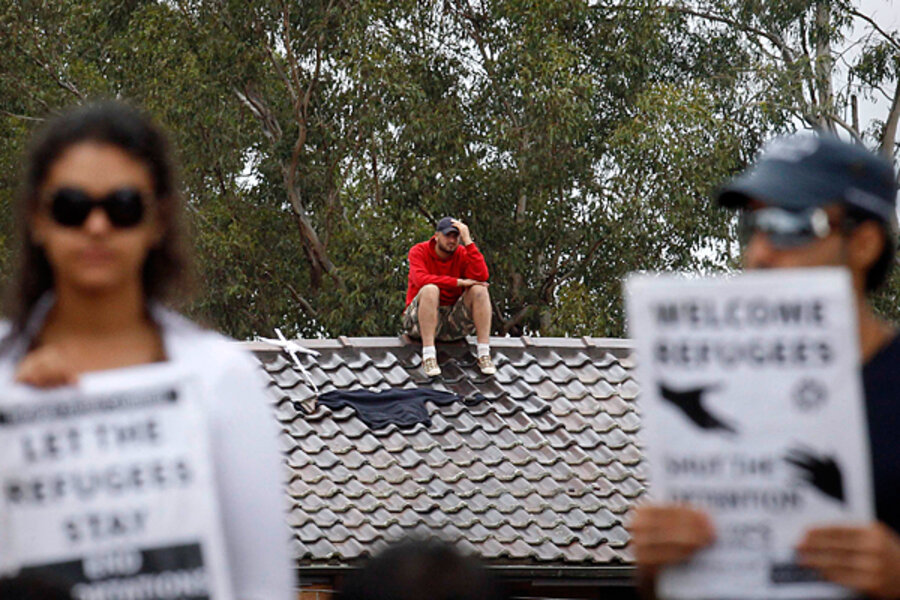Why Australia just toughened its tough immigration stance
Loading...
| Sydney, Australia
Riots and unrest at Australia's immigration detention centers have piled pressure on Julia Gillard's minority government, forcing her to adopt a raft of new measures including a "refugee swap" with Malaysia and negotiations to reopen a mothballed facility in Papua New Guinea.
The steps have prompted accusations from critics that the Labor government is copying the policies of the former conservative prime minister, John Howard, who gave Australia an international reputation for taking one of the hardest lines on asylum-seekers – although the numbers coming here are minuscule compared with those arriving in the US and Europe.
Under a deal struck with Kuala Lumpur, Australia will send 800 "boat people" to Malaysia for processing by the United Nations. In return, it will accept 4,000 mainly Burmese refugees currently in Malaysia awaiting resettlement. The aim is to deter asylum-seekers from making the journey to Australia via Indonesia, but the plan has been attacked by refugee and human rights groups, including Amnesty International.
An Amnesty report last year described Malaysia’s immigration detention centers as filthy, overcrowded, lacking in proper healthcare, sufficient food, and clean drinking water – and rife with abuse by staff.
The Australian government is also talking to Papua New Guinea about reopening a detention center on remote Manus Island, which was used to process asylum-seekers under former Australian Prime Minister John Howard, or building a new one there.
The refugee issue was thrust back into the political spotlight by the disturbances at centers around Australia, where asylum-seekers – mainly from Afghanistan, Sri Lanka, and Iraq – are housed while their claims are considered. At the Villawood facility in Sydney, disgruntled detainees set fire to four buildings recently, then staged an 11-day rooftop protest. Other facilities, including the main refugee processing center on Christmas Island, an Australian territory in the Indian Ocean, have also experienced trouble.
Amid the public outrage sparked by the Villawood riot, Australia's Immigration minister, Chris Bowen, announced last month that asylum-seekers convicted of a criminal offense – such as property damage – will not be given a permanent residency visa, even if their refugee claim is upheld.
Trapped
The issue has highlighted Ms. Gillard’s precarious position, as Labor languishes in the polls. Political analysts say the government’s hands are tied. If it softens its policies, heeding calls from refugee advocates and the small Greens party, it risks alienating its traditional working-class base. If it hardens them, it will upset its educated, middle-class supporters.
“The government is in a real bind,” says Norman Abjorensen, a political scientist at the Australian National University. “It’s trapped between two very different poles, and whichever way it goes, it will be savagely kicked. And the more this goes on, the more its support will be eroded.”
Refugee groups, meanwhile, say that the new measures will not address what they say is the main cause of the disturbances: delays in processing asylum claims and security checks, leading to refugees being detained for up to 18 months in mostly remote, overcrowded facilities.
“The government is creating the very circumstances and duress that push people into carrying out these protests," says Ian Rentoul, a spokesman for the Refugee Action Coalition. "Long-term detention creates mental anguish and anxiety, and eventually mental illness. The response to the riots is just politicking, and will do nothing to stop the protests.”
Mr. Rintoul says there were hopes that when Labor came to power in 2007, it would take a more humanitarian approach to the asylum issue. “But at every stage they have just become more draconian.”
Immigration: the politically explosive topic
The issue's political explosiveness despite the small numbers involved – about 6,500 people made the journey by boat last year – is rooted in geography and in history, Dr. Abjorensen believes. As a European settler nation in the middle of Asia, Australia has always feared its neighbors, including the Chinese, who came to work in the goldfields in the 1850s, and the Japanese, who bombed Darwin during World War II. For much of the 20th century, the “White Australia” policy barred entry to nonwhite immigrants.
“In the public mind, the [refugee] issue is connected with national security,” says Abjorensen. “So if a politician wants to play that card, there’s always very dry grass to be set alight, and it’s very difficult for the government to defend itself.”
Gillard’s government has urged Indonesia to crack down on the “people smugglers” who transport asylum-seekers to Australia in often unseaworthy boats. The talks with Malaysia began after she failed to persuade East Timor to allow Australia to build a regional refugee processing center there.





